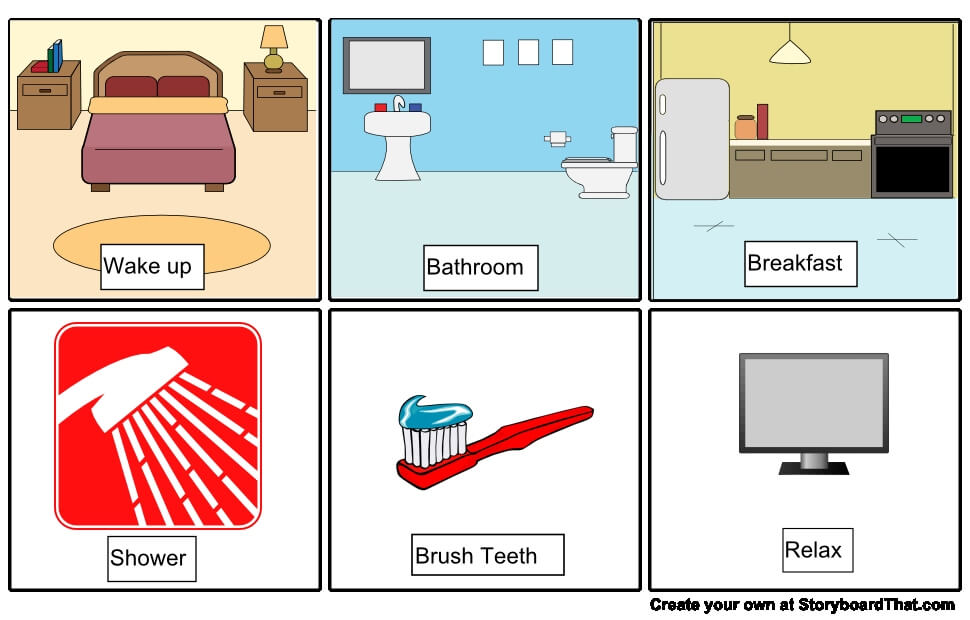The morning can be the hardest part of the day. Not only do you (the often exhausted parent) have to get yourself up and ready, you have to get your child up, dressed, fed, prepared for the day and out the door when the bus arrives. Establishing a morning routine is essential to achieve success. Routines provide predictability and help to relieve anxiety and uncertainty. In addition, routines allow an individual to have greater control over their environment. Sticking to a similar morning routine could mean all the difference between having a good day and having a bad one. Below are some tips for creating a morning routine.
Use Visual Supports
Sequencing can be difficult for individuals with special needs. Using pictures or symbols to identify what is expected each morning will help your child work towards independence. A schedule that sequences morning activities takes the guesswork out of what needs to be done. When a child is faced with too many choices, an unwanted meltdown can occur. By using visual supports, you can make the morning routine as general or specific as you would like. Some children may be able to use a general schedule that identifies each morning activity while others may require each activity be broken down into smaller steps. If your child is overwhelmed by picture symbols, try a short video that models the steps incorporated in the task.
Set the Alarm a Few Minutes Early
Getting up with extra time gives you and your child time to work through the morning routine with less stress and pressure. To offset the early rising, have your child go to bed a bit earlier each night. In the beginning, try to maintain the same wake-up and bedtime each day, even on the weekend. For an individual to develop a strong routine, it must be consistent.
Breakfast is Important
Mornings can be long and when you’re hungry they can feel even longer. Being hungry can also be the source of many noncompliant behaviors. Provide extra time in the morning to ensure your child has time to eat a good breakfast. Fill the kitchen with foods your child enjoys. By doing this you can help prevent a meltdown, which will “eat” into your valuable morning time. If the only thing your child wants to eat is peanut butter sandwiches that is ok. Eating something for breakfast is better than eating nothing. The bus ride to school can be long and will certainly be unpleasant if your child is hungry. If for some reason you run out of time and are unable to give your child breakfast, send it to school or write a note. Your child’s teacher can give him/her their breakfast. It is very important for the classroom teacher to know if your child did not eat breakfast.
Pick Clothes Out at Night
Encourage your child to choose and lay out their clothing before bed. By doing this you can eliminate one step in the morning and avoid a potential power struggle. Additionally, providing your child with an opportunity to select what they want to wear encourages choice making, empowers them, provides insight into their preferences (texture, color, etc.), and may lead to more positive behaviors related to dressing. Keep in mind sensory issues and other preferences that may create problems in the morning. If your child is attached to a purple t-shirt, purchase several so they will always have a clean purple shirt to wear.
No Electronics Until Everyone is Ready
Save watching TV, playing on the computer, and/or using the iPad for after everyone is ready. Electronics can be distracting and can slow down your morning routine. Furthermore, electronics can be the source of a power struggle between you and your child and cause a meltdown. If your child has a hard time with not watching television or using the iPad, try playing music as a substitute. Music can be calming and help your child to focus better. Try playing a different song for each morning task or completing the task to the beat of the music. Get creative and you’ll see how much fun the morning routine can be!
Resources
http://www.livingwellwithautism.com/how_to_use_picture_cards_and_schedules/self_care_visual_helpers

